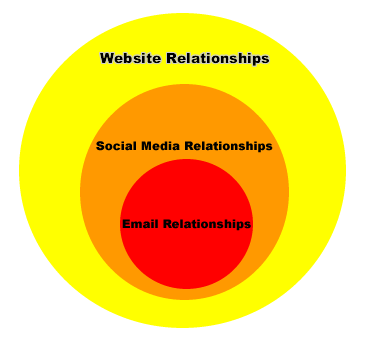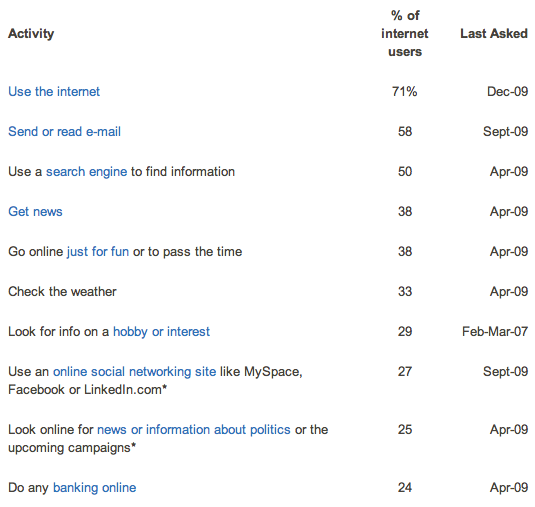Email Communications is Still on Top for Daily Usage
One of my favorite features at Sacramento Magazine in the 80s was called “What’s in Your Refrigerator?” We would send an editor and photographer out unannounced to the home of some local celebrity. If at home, the celebrity would usually let our intrepid journalists barge into their home and take a photo of the contents of their fridge. The reporter would then interview the owner about the contents, working hard to uncover some deep, dark secret that would amuse our readers. The fridge feature was never going to win us a Pulitzer, but it did generate some good buzz and helped define Sacramento Magazine as part of the community.
If Effective Email Communication is Important to Your Business
It occurred to me that the 2010 version of the fridge feature might be called, “What’s in Your Email Inbox?” I admit it is less amusing, but if you rely on effective email communications to run your business like we do at Mequoda Group, the answer to the question is as serious as a heart attack.
————————————————————————
Learn how to build a more effective website homepage in less than 90-minutes on May 4th, 2010… Act quickly and your website could be chosen for a free website design makeover by Nancy Horan and the Mequoda Design Team.
————————————————————————
As I continued to muse about the question, I decided that my own email inbox would be a good place to start. (Tom Wolfe would be proud.) Given the sheer number of emails I receive in a week, a photo did not seem the way to tell this story. Like a good journalist, I decided some random poking around might offer up a clue as to how to get a better handle on the contents of someone’s email inbox.
I discovered that I receive between 300 and 400 emails per week in my primary email inbox. After staring at the contents for a while, I concluded the emails I get could be divided into four categories:

Personal Correspondence: More than seven out of ten emails in my primary inbox were from family, friends and colleagues. About half of these emails were addressed to me and usually required a response. The balance was made up of emails to someone else where I had been copied, and emails sent to a distribution list. Hence, a little more than 100 of these emails required a reply.
Email Newsletters & Alerts: About 12 percent of the emails in my primary email inbox are newsletters and news alerts. The newsletters that make it into my primary inbox are the ones I want to read during the week. They include our own Mequoda Daily, SIPAlerts, TSI Network Daily and email newsletters from MPA, OPA, Audible and eMarketer. I have a separate email inbox for the other email newsletters I get and read on the weekend, which amounts to another 300 to 400 emails per week. This includes all the Mequoda Gold Member newsletters plus others I monitor for best practices and still others I like to read for their content.
Account Updates & Alerts: While this category is the smallest of my wanted emails, they are perhaps the ones I often read first. They include receipts and confirmations for flights, hotels and cars. Also included are bank, credit card and brokerage alerts, confirmations and statements. And finally, receipts from online purchases for merchandise, books, memberships and subscriptions. When I order something from Amazon or Apple, I often check the email receipt to make sure I placed the order correctly. (I recently purchased a magnifying device from Amazon and accidently sent it to my brother-in-law by mistake… but that’s another story.)
[text_ad]
Junk Mail: Try as I might, some junk mail still manages to slip through both server and client filters making it into my primary inbox. For the most part, the sender seems to think I either need a date or help with activities one might associate with serious dating or marriage. My wife Gail finds this amusing. As I find these emails intensely annoying, I was surprised to find that they were such a relative small percentage of weekly emails.
I spend about 15 hours a week reading and responding to the above emails. Most of my colleagues would offer a similar analysis. This does include the time it takes to read what I am sent, read and digest hyper-linked pages and attachments, and respond in writing with replies that range from “sure” and “super” to longer lists and even occasional edits of everything from an upcoming post to a legal agreement. My world may be largely paperless, but it is rich with words, images and sounds that I must absorb, digest and act upon. And my primary email inbox is the tool that allows me to keep it all organized, flowing and findable when I need it.
Is Email Dead?
An otherwise intelligent reporter from NPR recently asked our editor Chris Sturk this question. Chris echoed findings that can be found on a recent Pew Research report that has “sending and receiving email” as the most popular daily Internet activity. Perhaps Chris should have suggested the reporter from NPR look at their own inbox to answer their question.
This is not the first reporter to ask the “Is email dead?” question. The rapid rise of social media seems to be the source of the question. The logic seems to be that if time spent with social media is growing, and then time with email must be shrinking. While the question assumes correctly that there are only 24 hours in a day, media consumption trends are far more complex.
For starters, users multi-task and may be listening to music, reading email, chatting on twitter, responding to SMS and talking on the phone all more or less at the same time. There is the question of reading newspapers or watching TV. If I am reading the WSJ on my Kindle or iPad, am I using the Internet or reading a newspaper? If I am watching Terminator on Hulu, am I “using the Internet to entertain myself“ or watching network TV? When a colleague invites me via email to link to them on Linked in, am I reading email or engaging in social media? Digital media encourages mutli-tasking in an unprecedented way.
Email Communications is on the Rise
Mark Twain said that “Figures don’t lie, but liars figure.” When 58% of the 71% of people who use the Internet use email every day to send and receive messages, the annual growth rate of email usage will tend to level out. But do not mistake this fact, for the drivel that some mainstream media types are reporting: that social media is taking the place of email communications.
For starters, email communications remains the undisputed #1 daily activity for Internet users. Think about my email box and yours. Do you really want the stuff that is happening in your email inbox and outbox to happen in Twitter and Facebook? I do not. Twitter, Facebook and LinkedIn are public forums for water cooler conversations. Are they an important part of the marketing mix for your media brand? Sure. Are they, or will they, be the place where your more trusted information is sent, responded to and stored? I think not.

Building Email Relationships is More Important than Ever
While building social media relationships is as critical to building website traffic as great content and referring links, it is no replacement for building effective email permission-based relationships. Mequoda Gold Members continue to report that 60 to 80 percent of their online revenue comes from email page views and clicks. Email readers are the core of your online user relationships, social media subscribers have the next level of commitment, and most of the one-time visitors to your website won’t remember you or your brand tomorrow.
The Mequoda Website Design Workshop
Let Mequoda Group’s Nancy Horan and Kim Mateus show you how to build a better website. Learn the secrets for designing a website that begins long-lasting email relationships and keeps users coming back again and again. Learn more information about the Mequoda Website Design Workshop on May 4th, 2010.



